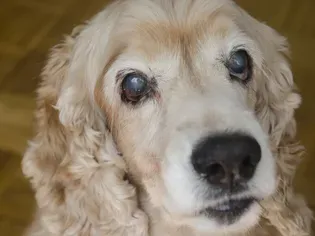Cloudy Eyes in Dogs
Updated on 04/26/24

Cloudy Eyes in Dogs: A Comprehensive Guide to Causes, Symptoms, and Treatment
Cloudy eyes in dogs, also known as cataracts, are a common condition that can affect dogs of all ages and breeds. While they can be a harmless cosmetic issue, they can also be a sign of a more serious underlying health condition.
Causes of Cloudy Eyes in Dogs
* Age: Cataracts are most commonly seen in older dogs, as the lens of the eye naturally ages and becomes cloudy.
* Genetics: Some breeds of dogs are more prone to cataracts, such as Poodles, Labrador Retrievers, and Golden Retrievers.
* Trauma: An injury to the eye can cause the lens to become cloudy.
* Diabetes: High blood sugar levels can damage the lens of the eye, leading to cataracts.
* Other health conditions: Certain diseases, such as uveitis (inflammation of the eye) and glaucoma (increased pressure in the eye), can also cause cataracts.
Symptoms of Cloudy Eyes in Dogs
* White or cloudy appearance of the eye: This is the most obvious symptom of cataracts.
* Blurred vision: Dogs with cataracts may have difficulty seeing, especially in low light conditions.
* Eye irritation: Some dogs may experience redness, swelling, or pain in the affected eye.
* Changes in behavior: Dogs with cataracts may become more hesitant to move around or play, as they have difficulty seeing.
Diagnosis of Cloudy Eyes in Dogs
If you suspect that your dog has cataracts, it is important to take them to the veterinarian for a diagnosis. The veterinarian will perform a thorough eye exam, including:
* Visual acuity test: The veterinarian will check your dog's vision by having them follow a moving object.
* Slit lamp exam: The veterinarian will use a special light to examine the lens of the eye for any abnormalities.
* Tonometry: The veterinarian will measure the pressure in the eye to rule out glaucoma.
Treatment of Cloudy Eyes in Dogs
The treatment for cloudy eyes in dogs depends on the severity of the cataracts and the underlying cause.
* Medical treatment: If the cataracts are caused by an underlying health condition, such as diabetes, treating the condition may help to slow or stop the progression of the cataracts.
* Surgery: In some cases, surgery may be necessary to remove the cataracts. This is typically only recommended if the cataracts are severe and are affecting the dog's vision.
Prevention of Cloudy Eyes in Dogs
While there is no surefire way to prevent cataracts in dogs, there are some things you can do to reduce the risk:
* Regular eye exams: Regular eye exams can help to detect cataracts early on, when they are more likely to be treatable.
* Control blood sugar levels: If your dog has diabetes, it is important to keep their blood sugar levels under control to prevent cataracts.
* Avoid eye injuries: Keep your dog away from sharp objects and other potential eye hazards.
Conclusion
Cloudy eyes in dogs can be a harmless cosmetic issue or a sign of a more serious underlying health condition. If you suspect that your dog has cataracts, it is important to take them to the veterinarian for a diagnosis and treatment. With early diagnosis and treatment, most dogs can live a happy and healthy life despite cataracts.
Additional Information
* Types of Cataracts: There are different types of cataracts, including nuclear cataracts (which affect the center of the lens), cortical cataracts (which affect the edges of the lens), and posterior subcapsular cataracts (which affect the back of the lens).
* Progression of Cataracts: Cataracts typically start out small and gradually get larger over time. In some cases, they may progress rapidly, while in other cases they may take years to develop.
* Treatment Options: There are a variety of treatment options for cataracts, including surgery, laser therapy, and eyedrops. The best treatment option for your dog will depend on the severity of the cataracts and the underlying cause.
Explore More Pets

Basic Training
Puppy and Baby Introductions

Working Dog Breeds
All About Search and Rescue Dogs

Dog Treatments
Puppy Vaginitis: Signs, Causes and Treatment

Dog Adoption
After More Than 1,200 Days in the Shelter, Coco Goes Home

Basic Training
How to Train Your Puppy to Go on Potty Pads

Hybrid Dog Breeds
The Difference Between a Mutt, Mixed Breed, or Designer Dog?

Dog Treatments
Nail Problems in Dogs

Puppies
7 Reasons Why Two Dogs Are Better Than One